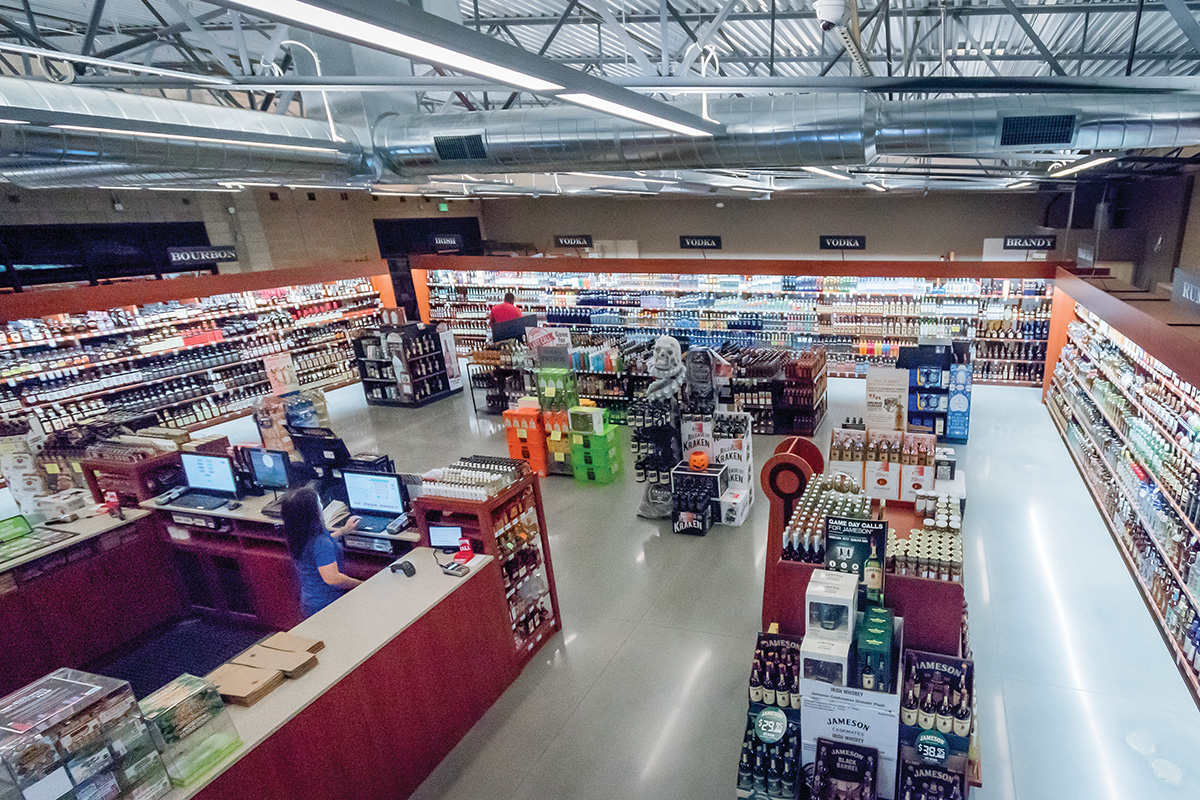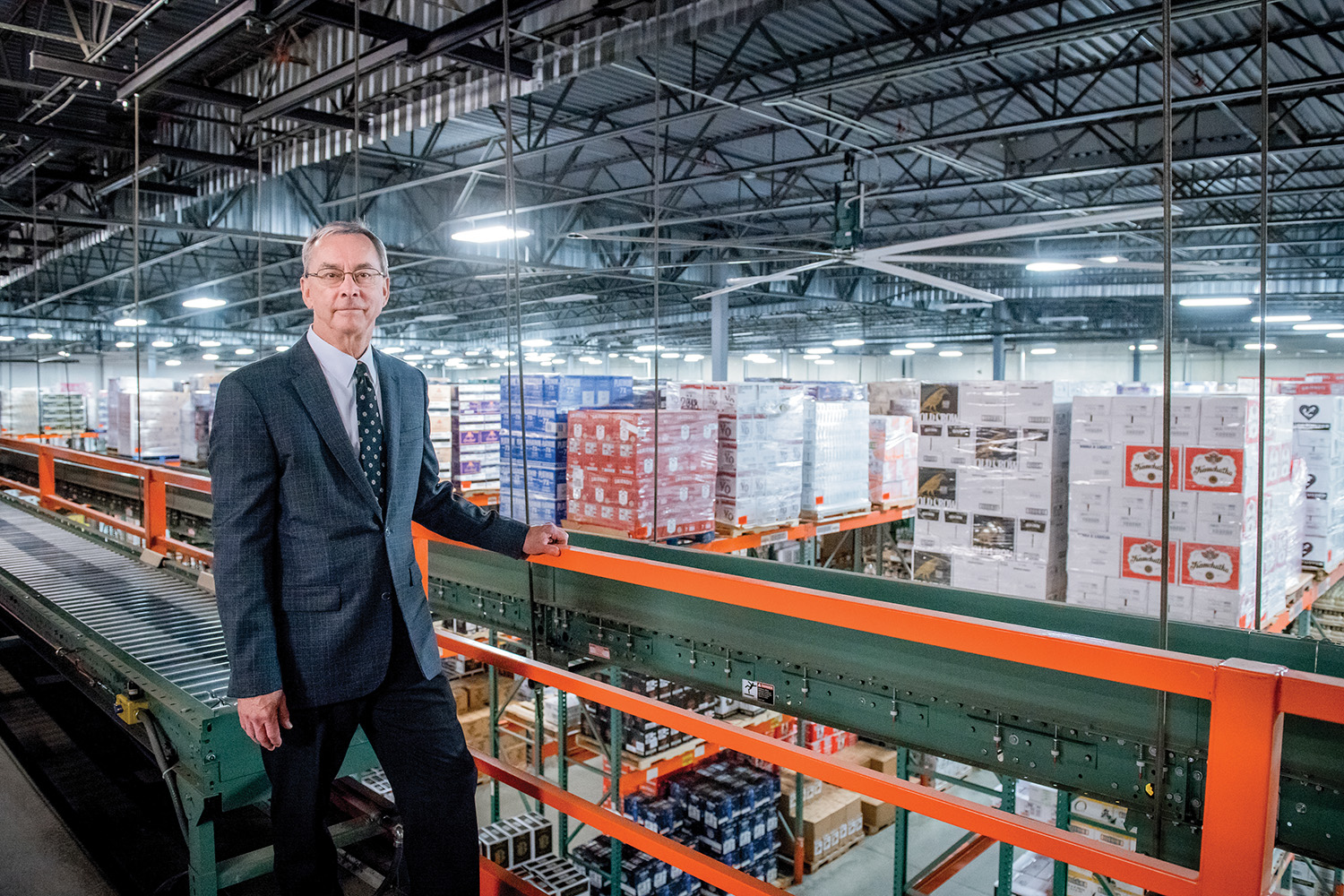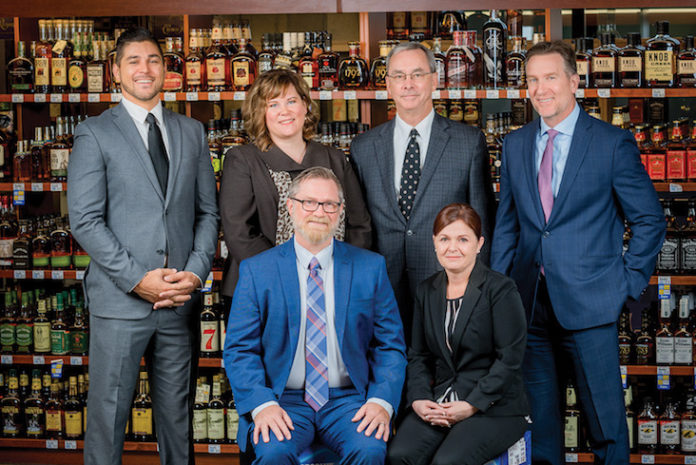Liquor in Idaho is the fifth largest source of revenue in the state. It generates more than the sales of cigarettes, other tobacco and beer and wine combined.
Based in Boise, the Idaho State Liquor Division (ISLD) manages the distribution and sale of distilled spirits across the state. It currently operates 66 state stores — with one new location scheduled to open next spring — and oversees 105 agency stores, which are primarily located in Idaho’s most rural communities.
Jeffrey Anderson assumed the role of Director of the ISLD in 2010, and was recently re-appointed for another term by Governor Brad Little. Anderson also holds a joint appointment as Director of the Idaho State Lottery, a position he’s held since 2007. Customer service has been a priority for Anderson since his arrival at the ISLD. At that time, the agency was undergoing a legislative performance audit, and much talk centered around the possibility of privatization.
“That was an intensive process, but it was incredibly helpful in helping us introspectively consider how we can best serve our citizens,” Anderson says. “Idaho is the fastest-growing state in the nation in terms of population. It was essential for us to develop a better understanding of consumer needs and implement new methods to serve our customers better.”
Since Anderson’s arrival, the agency has seen profits increase by 81%. He and his team (which includes 25 administrative staff, 25 warehouse distribution staff and 370 retail employees) are evidently on the right track.

Modernization
As a result of the audit, Anderson led the ISLD in an ambitious modernization campaign across the agency and its state stores, focusing on providing consumers with a world-class customer service experience. The modernization campaign is an ongoing process, but has already resulted in Idaho zeroing in on an optimal store size and product mix.
In the past decade, the agency has cycled through all the leases of its agency stores, and made significant adjustments in terms of moving many store locations and completely renovating others.
Store displays and shelving were adjusted to make shopping easier for customers and display products more effectively, which resulted in an increase in the sale of super-premium products. Lighting and flooring have been updated at many stores. Some innovative new product sections include a home bar section stocked with affordable products designed to help customers create and stock their home bars for the first time. A small-size product section gives consumers an opportunity to try new products offered in smaller sizes than the traditional 750-ml. bottles.
“We aren’t afraid to try new things,” Anderson explains. “We constantly measure, refine, then measure, and continue to refine. Sometimes we abandon things that aren’t working and move on to something new. It’s a process of constant improvement.”
A comprehensive go-to-market strategy has been developed for all agency stores, resulting in a much more targeted set of products selected based on consumer purchasing data. The agency also does more advanced forecasting than it has in previous years. For example, the marketing strategy for the 2020 winter holidays has already been set for some time. Sally Ray, Deputy Director of Retail Operations, says the ISLD brings data to the forefront of all its retail decisions.
“By looking at consumer data and really focusing on the customer experience, we can identify what’s most important to them and make changes that result in maximizing revenue for the people of Idaho,” Ray adds.
In terms of products selection, Idaho is experiencing a resurgence in the bourbon, whiskey and scotch categories.
The agency offers a number of rare bottle releases throughout the year, which are extremely popular with customers. Several rare whiskey releases were announced on the ISLD website last year, and customers could enter a lottery for an opportunity to purchase these products, which were available in extremely limited quantities. During the last rare whiskey lottery, web traffic to the agency’s website increased by 300%. Live rare whiskey store events generally draw several hundred customers to each one.
The ISLD is committed to constantly evaluating its product selection, and making changes to keep up with industry trends and consumer demand.

A group known as the quick-list committee meets seven times per year, to evaluate new products submitted by suppliers for consideration. The committee includes representation from retail store staff and on-premise managers to ensure products are vetted appropriately, and that the right products are selected to meet current consumer needs. The agency also looks at incorporating new product selection methods in the near future.
“We want to move away from relying so much on supplier product submission, and make sure we are doing a better job of asking for or identifying products ourselves that are a good fit for Idaho,” says Raymond Homen, deputy director of procurement and distribution.
Technology has been another area of improvement for the agency, which is currently in the process of transitioning from its current 20-year-old enterprise resource planning (ERP) system to a new system being introduced across all Idaho state agencies. The new ERP will encompass a tier-1 system that is cloud-based and offers an updated point of sale (POS) system. About $100 million has been allocated to transition to the new system, a process that began in October 2019. It’s estimated that it will take up to two years for all aspects of the agency and its partner stores to be up and running.
“Technology-wise, things have changed substantially in the last 20 years and are much more modern and smooth,” says Jon Spence, deputy director of information technology and security. “This new system will mainly help us with inventory, but will also feature improvements that assist with human resources and finance.”
The ISLD recently migrated to Office 365, and will soon implement a 4G backup to all its agency stores in order for credit card machines to no longer be dependent on phone lines. Plans to upgrade the warehouse’s voice-to-pick (VPIC) system are also underway, and the ISLD’s online presence has also been enhanced.
A new customer-facing website that incorporates the agency’s “Mix, Blend, Enjoy” branding allows consumers to easily access information about store locations, hours, products, drink recipes and more. A new on-shelf digital tablet program will pilot at several stores this fall, giving customers quick access to product information. The agency hopes to introduce the digital tablets to all stores next year, and is currently exploring e-commerce options to introduce buy online and pay/pick up in store options in the near future.
Warehouse enhancements have been another area of focus for the ISLD. The agency generally has about 32,000 SKUs at any given time, and has increased the total number of SKUs by 28% over the past eight years. With 1.1 million cases going out every year, the state has also seen a 90% increase in the number of products picked by the bottle, resulting in the need for more resources. To address this, the warehouse has increased the number of locations set up to pick by the bottle, allowing it to fulfill customer orders more quickly.

Focusing On Compliance
In addition to generating revenue for the state, the ISLD also oversees education, responsible serving and compliance — all of which remain top priorities for the agency.
During the 2018 calendar year, Idaho liquor stores processed more than eight million retail transactions. During that time frame, there were zero citations for underage selling issued across the state.
ISLD administrators say this impressive statistic is due to the agency’s commitment to responsible service. All retail store employees must complete a comprehensive onboarding process that features an online management training component. The online training includes a video series on verification processes, information on responsible service practices, Training for Intervention ProcedureS (TIPS) training and more.
Additionally, employees take part in a customer experience training program that focuses on skills like greeting customers when they enter a store, and helping them find exactly what they’re looking for. A mystery shopper program also helps the ISLD evaluate and improve customer service experiences.
Idaho utilizes the BARS Program, an internal compliance program that revolves around retail testing conducted by individuals ages 21 to 25, all who should be asked to show proof of age when attempting to purchase alcohol. After implementing the BARS Program in 2015, the agency experienced a significant decline in the number of citations for underage serving.
Other training opportunities include twice-yearly in-person meetings with agency administrators and all store managers, along with a biannual trade show that invites all managers and licensees to network with suppliers and learn about new products. The ISLD also maintains close working relationships with local and state police.
“Not every town is the same, and communities across the state different needs,” Anderson explained. “We work very hard to ensure that we’re keeping products out of the hands of people who are underage.”
One way the ISLD shares its prevention and compliance messages with the community is through a mini grants program sponsored by the National Alcoholic Beverage Control Association (NABCA). This solicits applications from groups across the state interested in starting their own underage drinking awareness programs. The program began in 2012, and the ISLD gave away $10,000 in mini grant awards that year. Thanks to financial support provided by NABCA, the program has grown, and this year the agency plans to award $60,000 in grants.
“We have $150,000 in asks this year, which is much more than the current program can support, but it’s indicative of the desire people have to get involved,” says Catie Wiseman, education manager. “I’m so thankful for the resources we have, but there’s still so much work to be done. Hopefully the program continues to grow every year.”
The NABCA partnership is something the ISLD deeply values.
“We are very, very grateful for our membership in NABCA,” Anderson says. “They are critical to our ability to provide service. It’s more than the money. The staff of NABCA is world-class. They’ve helped us create an array of advocates for what we do. Just looking at the recipients of the mini grant program; it’s absolutely amazing to see what these groups are able to do with these awards.”

Looking to the Future
In addition to focusing on steady revenue growth and looking into ecommerce options, the ISLD is also thinking about upcoming legislation and how it might affect daily operations. Last year, a bill to get wet tastings permitted in stores failed to pass, but Anderson says the agency is cooperating with plans to re-introduce a similar bill in 2020.
“Right now the law prohibits any in-store tastings, which is a missed opportunity for our customers and our business partners,” he says. “We know this is something we can administer responsibly, as many other states already do, and we hope the legislature will help us continue to transform our operations and offer the best possible customer service for the citizens of Idaho.”
The agency is also keeping a close eye on the low unemployment rate across the state, which, while a good thing overall, has resulted in challenges for maintaining a retail workforce.
“Washington is one of our border states, and they’re looking to increase their minimum wage soon, which will be more than our starting wage,” says Tony Faraca, chief deputy director and chief financial officer. “We need to continue finding ways to make this a compelling and competitive place to work.”
As it stands, the agency forecasts that it will contribute $1 billion in revenue to the Idaho state general fund over the next decade. Anderson credits the continued success of the ISLD to the agency’s employees.
“I don’t do the work, the team does,” he says. “We have a very strong and dedicated workforce in our central office, in our agency stores and in our distribution center. None of this would be possible without their continued support and desire to continue improving what we do for our customers.”
Thanks to the efforts of Anderson and the rest of the ISLD team, the agency is poised to continue forward on its journey toward even higher levels of success. •
Melissa Sherwin is a freelance writer and marketing communications strategist from Chicago, IL. Her work has appeared in Chicago’s Daily Herald newspaper, Time Out Chicago, Suburban Life newspapers, and various magazines. She is also the author of several children’s books. Follow her on social media @MelissaNSherwin.










